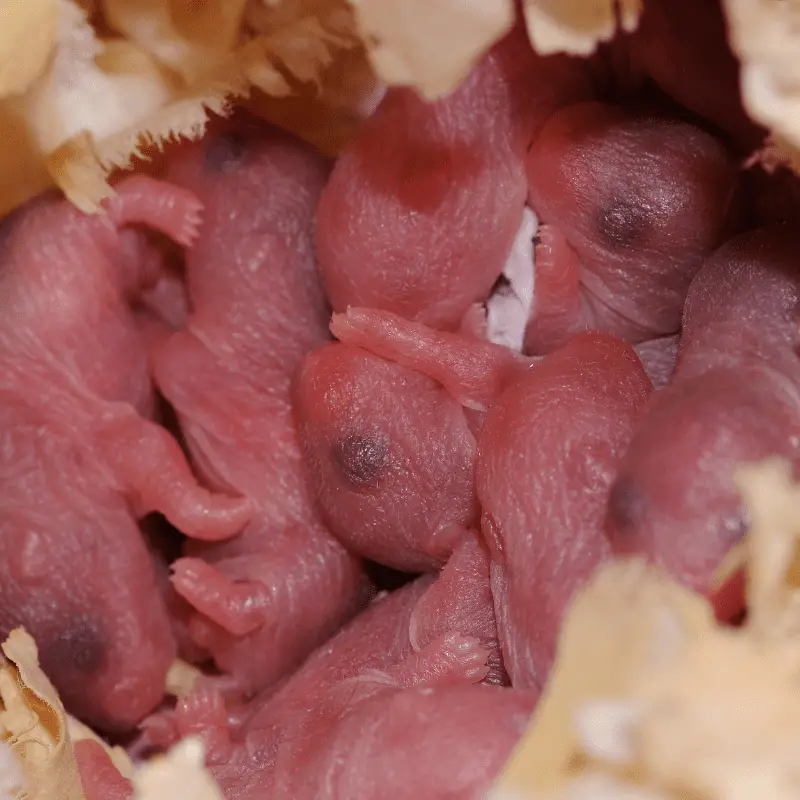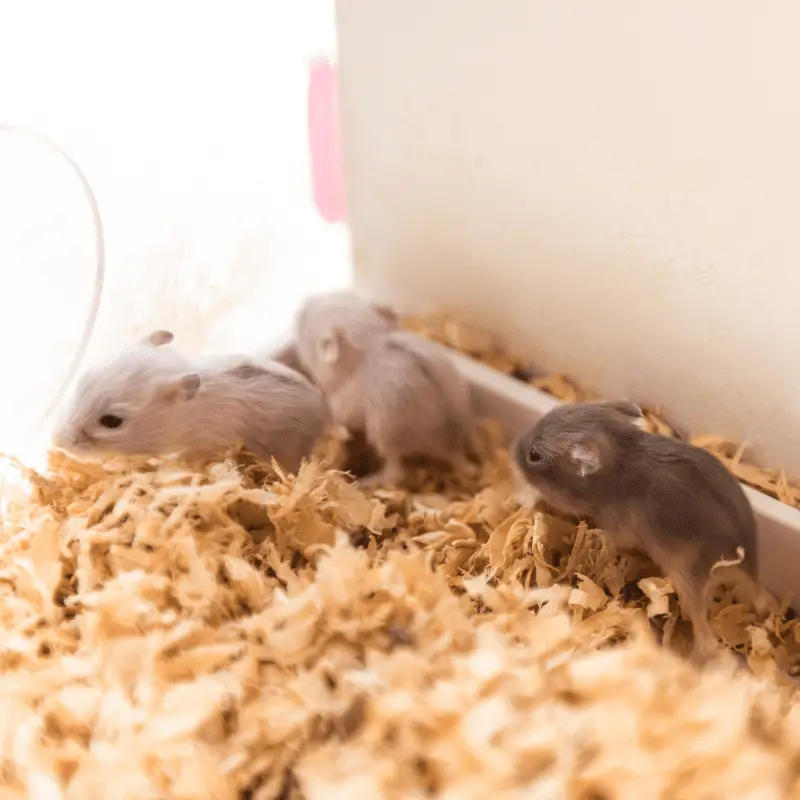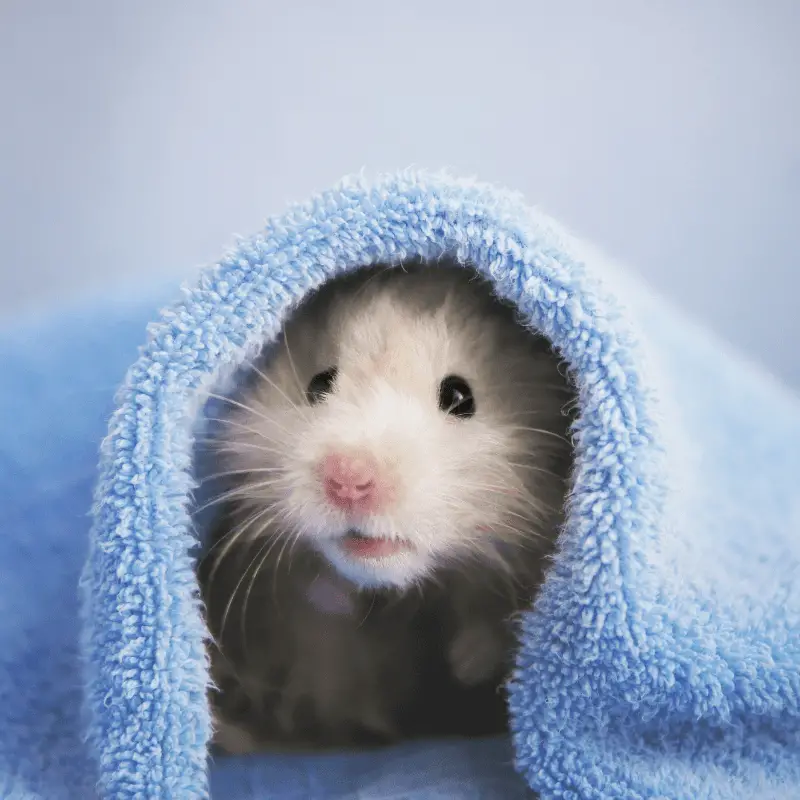Among all the well-known pets, the hamster reproduces at an overwhelming rate. That raises the question of how many babies a hamster can have at a time?
Hamsters can give birth to up to 20 baby hamsters at any one time, but the average range for a single litter ranges from 6-12. After they’re born, the babies are nursed by their mothers for roughly two to three weeks. After this time, the babies go onto regular food. Three to four weeks of age, the different sexes should be separated into two groups, leaving the mother with the females.
Is your hamster pregnant? Here is some advice that can help you deal with the situation better and understand what you need to do through the ageing process up until eight weeks old.
How to tell if a hamster is pregnant?
You will know if a hamster is pregnant by the larger size of her girth or abdomen. She may also seem out of character than normal, such as restless and more active. At the time of immediate delivery of her babies, she may also have some vaginal bleeding.
Keep Her Comfortable
It would help if you kept the nursing hamster mother well fed and hydrated. Make sure to keep the hamster mother and her babies in a low-stress and quiet environment. The hamster mother must be kept stress free, or they are known to kill their young.
Cage Care Advice
If you have just noticed that your hamster is pregnant, you should clean the enclosure properly and prepare it for the exciting new arrival of the babies.
Do not try to clean the cage immediately after the babies have arrived. You can, however, add some extra fresh bedding, but leave the old still inside the cage, so she is familiar with her surroundings.
Dont Disturb Them
Leave the Hamster mothers and their babies alone for at least a week. Not disturbing a new mother is especially important, especially if the female hamster becomes a mother or the first-time mother. If cleaning is a must, then you should try a spot clean. But it is always better not to disturb the nest of the mother and the babies at all. Hamsters, by nature, are incredibly territorial, and messing with her nest at such a delicate time will only stress her out. Don’t try to hold her or the baby hamsters as well. However excited you may be, you must reframe from doing so for at least a week.
How long are hamsters pregnant?
The hamster gestation period is between 16 to 22 days. However, this depends on the hamster species, which the time can fluctuate from a few days.
See below a table of each hamster variety of how long each one is pregnant.
| Hamster Species | Gestation |
|---|---|
| Campbells dwarf hamster | 18-20 days |
| Chinese hamster | 18-23 days |
| Roborovski dwarf hamster | 20-22 days |
| Syrian hamster | 16-18 days |
| Winter white dwarf hamster | 18- 21 days |
Do hamsters give birth at once?
Yes, once one is born, the rest will follow one at a time. Delivery of the entire litter could happen very quickly or last a few hours, especially if they have many babies. Hamsters can have up to twenty babies in any one litter.
Feeding a Mother Hamster
Once you notice that your hamster is pregnant, you should make sure that you are providing a high-quality hamster diet to them. The diet of a pregnant hamster should contain high levels of protein. It would be best if you continued this diet throughout the pregnancy and nursing period.
You can stop this high protein diet once the babies eat regular food at around three weeks of age.
You can offer small amounts of cooked chicken or hard-boiled eggs and a tiny amount of cheese along with a high-quality diet. By doing this will give the mother a nutritional boost.
Never feed her too much, or she could well take it back to the nest, and it can become mouldy very quickly. Start to smell and attract unwanted attention from flies.
An essential high-quality diet is required during pregnancy and nursing. Save all the yummy treats like fruit and veg until after the babies reach three weeks.
Extra Protein
As suggested about you may add the above high protein options of plainly cooked chicken, cheese and hard-boiled eggs. Portion control is essential, and also how often you feed the mother hamster, the added extra protein. If she is not interested, remove the added protein.
Cheese
A fingertip size of cheese, these cheeses can include mozzarella, ricotta, and mild cheddar. Stay away from any mouldy cheese.
Hard-boiled eggs
A tiny 1cm by 1cm size piece, you can feed her any part of the egg. However, the yolk will be the most nutritious for her.
Chicken
1cm by 1cm size piece of cook plain chicken, never add any seasoning and make sure that it’s at room temperature before offering it to the mother hamster.
How often
Any of the above three options you can provide three times a week. For example. Monday she could have chicken, on Thursdays she could have a piece of a hard-boiled egg, then Saturday she could have a tiny bit of cheese. Then, you can repeat this each week. After the babies are three weeks old, you can introduce small amounts of fruit and veg again.
Separate the Hamsters
If the pregnant hamster is living with a couple of other hamsters, you should separate them as soon as possible. However, this is usually rare since most hamsters are solitary hamsters. But if you are lucky to have hamsters that get along happily, you will certainly need to separate them.
Separating the adult hamsters will keep the pregnant hamster and babies safe in case of any unwanted fighting between the adults. Even though they may not fight now, their character is much different when a mother hamster gives birth. It will also help you to avoid another unexpected pregnancy in the future.
Handling The Babies
Understandably, hamster babies are adorable, but you should try not to handle the babies at all for at least the first two weeks. It’s possible, if you hold them during this time, you will be spreading your scent to them, which could lead to their mother rejecting them.
If, for some necessary reason, you need to move a baby hamster, always use a spoon. By using a spoon this way, you will not be spreading your scent all over her babies.
Although, it is most unlikely that you will need to move a baby around even if they are out of their nest. Generally, if any babies stray away from the nest, the mother hamster retrievers them and returns them into the housing area.
Try to keep the watering and feeding time as calm and efficient as possible. During this time, when you are around the enclosure, try to stay quiet. Unexpected loud sounds often make the hamsters stressed.
Just right after giving birth, mother Hamsters tend to be very protective. That’s why they may act more aggressively than usual towards their owners. That is why it is better to stay away from the cage. She may stand on the hind legs and charge at you aggressively if you get too close. Understand that this behaviour is extremely natural, and there is no need to be anxious about it. But there is no point in getting bitten and stressing your hamster in the process. That is why you should try to keep your distance during this time.
When to Check On Them
As a responsible hamster owner, it is vital that you still have a watchful eye over her and the babies. It’s best to get a hamster house with a lid on so you can safely remove it and take a peek and pop it back on. Now and then, you can take an extremely calmful approach and check in on the mother and babies within the enclosure.
Veterinarian Help: If you notice anything unusual, you must call your veterinarian to check upon them.
When Visiting the Vets
When you are transporting them to the vets, you must do it calmly. If it’s rainy, snowy or windy weather outside, cover the cage with a sheet to avoid any damp or harsh winds getting in the cage, and also on a hot day, perhaps using a sun brolly, never cover the cage on a hot day, or they will overheat.
Dead Baby Hamster
Unfortunately, it’s a sad fact any birth for any animal that has more than one in any given litter can result in dead offspring, or after delivery, they are too weak to survive. If this happens, the mother hamster will either eat the dead hamster or drag it from the enclosure housing and leave it outside. At this point, you can take it away.
Baby Hamster Age Stages (What To Do and Expect)…
0 to 2 Weeks of Age
At this age, they are the sole responsibility of their mothers. The mother hamster will feed them her milk and keep them healthy. Between birth and two weeks old, you must not disturb them.

2 to 3 Weeks of Age
The mother hamster will start to wean their babies off her milk once they reach this age. The time frame of weaning depends on the number of babies in the litter. It also depends on the health of the individual hamsters. Even after this period, hamster babies can still try to nurse. However, their mother will discourage them strongly. During this time, try to provide an ample supply of food and fresh water to the young hamsters to make the transition easier. Even if the hamster food hasn’t been all eaten, replace it with new food each day. Never treat the baby hamsters at this age, outside of their high-quality hamster food. Their food is all they need at this time!
3 to 4 Weeks of Age
Depending on what you plan to do with the baby hamsters, either 1. find them homes or 2. keep them with you. This decision will establish your next steps to take.

1. Plan To Find Them Homes
Once they reach this age and the baby hamsters are healthy and happy. You can give them to their adopted hamster owners from this point. It’s certainly a sad time, but also a happy time to have found them a loving home.
2. Plan To Keep All The Hamsters
At this stage, if you are keeping them, it’s time to separate the males from the females. A hamster can start to reproduce again from this age, so if you dont want any unwanted babies, you must separate them—Males in one cage and females in another. The mother hamster should stay with the girls.
Identifying the sex of a baby hamster
It can be challenging to identify the gender of young hamsters. It is particularly true for the hamster babies of the dwarf varieties. However, you need to identify and separate the baby hamsters at 3 to 4 weeks of age to stop unintentional breedings.
You can try to tell the gender of hamsters apart by checking the distinctive markings on the underside of the hamsters. These two markings are situated right adjacent to the tail.
You will find the male hamsters bum and genitals will be further apart than those markings of the female hamsters. By checking the distance between them is pretty much the only way to tell.
So at this age, you should compare the opening positions of the hamsters and then divide them into separate groups.
- Further apart – Males
- Closer together – Females
If you are still unsure, you will need to take them to the vet gently, and they will separate them for you, make sure you take a spare cage to transfer the males into, leave the females in the mother’s cage. By isolating them correctly with a vet help, it won’t take long and is inexpensive, plus it will save any unwanted babies in the future.
8 to 10 Weeks of Age
You may start to find some territorial issues between the hamsters at this age because, after all, they are solitary creatures. When these fallouts occur, you will need to separate them even more. Yes, meaning they will all need their own cages. For example, if your hamster gave birth to eight babies, you will need eight cages, including one for the mother hamster. So that will be nine hamster cages altogether including the other bits like water bottles, food bowls, bedding and food. You may get lucky, and a few may get along. However, it’s hard to tell and maybe too late if you leave it. Hamster from eight weeks can become quite violent towards each other, especially if the cage is too small. Hamsters love their space!
Good luck with the cage cleaning. If you struggle to keep up with the cleaning, make sure you ask for help or don’t feel bad even considering rehoming some hamsters. There are many loving potential hamster owners out there screaming out for a hamster. I know, as at a few points of my life, I was one of them!

